10 Best Procurement Management Tools


With the increasing complexity of global supply chains and the growing importance of technology in streamlining procurement processes, it’s essential for businesses to leverage the right procurement management tools.
But what tools exactly?
In this article, we’ll explore some of the best procurement management tools that can help your business optimize procurement processes, reduce costs, and maintain a competitive edge.
We’ll start this list with our own AI-powered procurement solution, Veridion.
Unlike most other procurement management tools on this list that aim to cover all or most aspects of procurement, Veridion is focused on fueling those solutions with the freshest, weekly updated data on suppliers around the world.
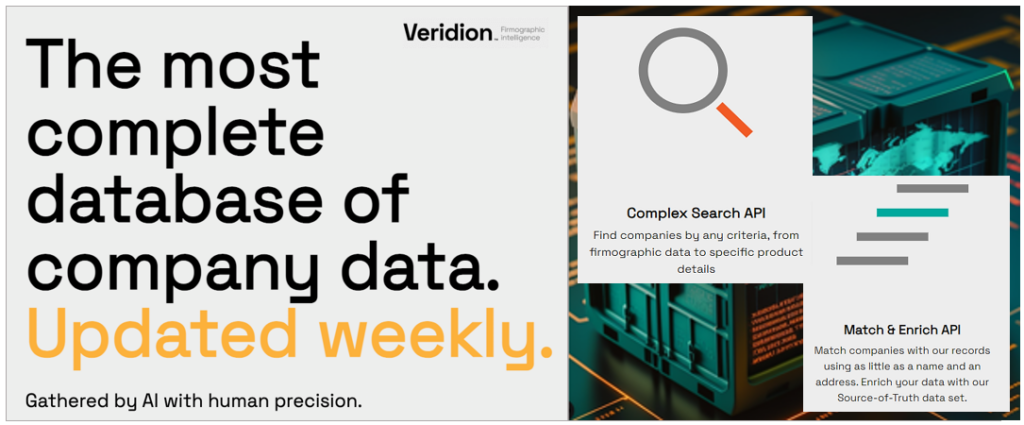
Source: Veridion
Veridion consists of a cloud database that’s regularly updated with info collected by our proprietary and still unmatched AI-driven, machine learning algorithms.
This data can then be searched by using Veridion’s APIs—which are easily integrated with your other procurement management solutions—to find suppliers by any criteria (Complex Search) or to enrich your supplier profiles with the freshest data (Match & Enrich).
This means that Veridion is most useful when you need to find new suppliers and evaluate them against a range of specific procurement criteria.

Source: Veridion
As highlighted above, the often time-consuming and complex process of supplier discovery and sourcing can be streamlined, enabling your team to create a shortlist of potential candidates in a few minutes instead of days or weeks.
Of course, Veridion’s data collection and analytics features offer additional functionalities, such as:
Here’s the last item in our bullet point list explained in more detail.
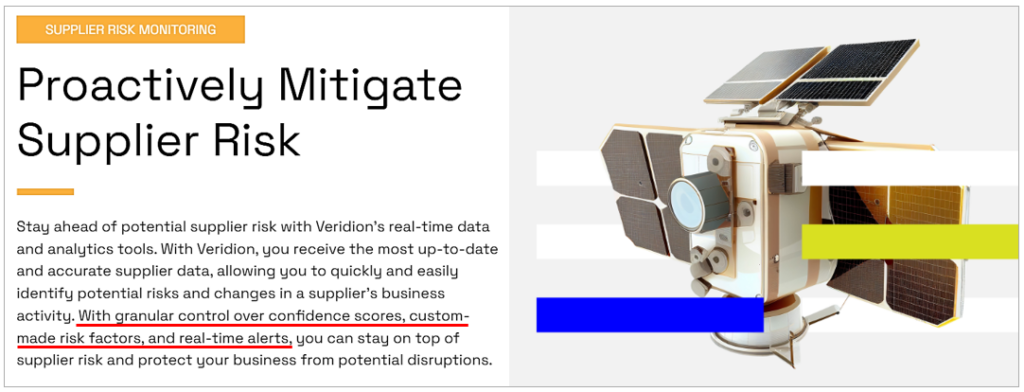
Source: Veridion
As for pricing, it’s flexible and tailored to each company’s data needs, so feel free to contact us and ask for a quote.
To recap, think of Veridion’s database and advanced search functions as a powerful tool for gaining real-time insights about your potential and existing suppliers that enable better-informed, data-driven procurement decision-making.
ProcureDesk is a comprehensive procurement management solution that streamlines purchase orders, approvals, and vendor management.
With its robust features and user-friendly interface, ProcureDesk is an excellent choice for small and midsized businesses looking to optimize their procurement processes and achieve greater control over their supply chain operations.

Source: ProcureDesk
Some of ProcureDesk’s key features include:
Moreover, ProcureDesk’s services include helping you set up your organization’s custom purchasing rules, thereby streamlining the approval process for up to 90% of purchase requests.
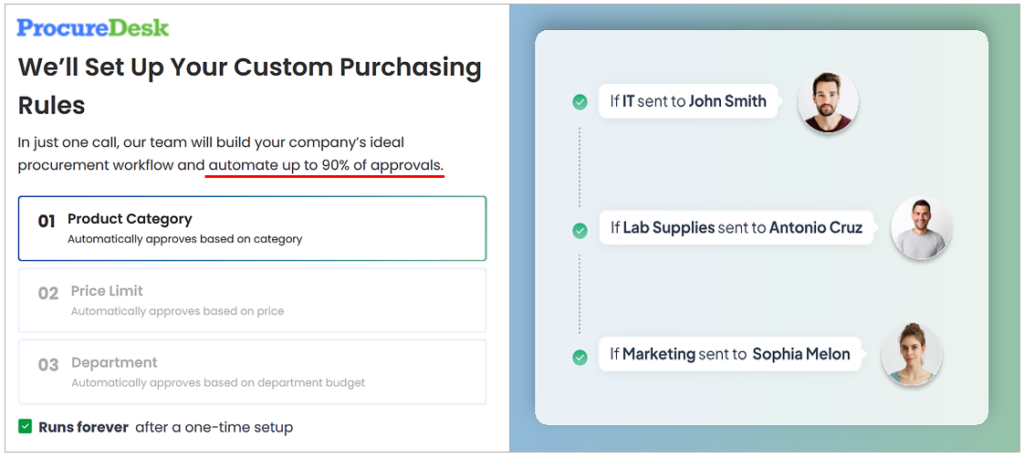
Source: ProcureDesk
ProcureDesk also offers vendor integrations for more than 150 suppliers, enabling you to place orders with these suppliers directly from the platform, i.e., without having to manually enter the order information.
Additionally, your procurement processes can greatly benefit from ProcureDesk’s data migration and software integration features.
Whether you want to turn your spreadsheets into interactive documents, connect ProcureDesk with your accounting software, or add specific suppliers’ catalogs, they’ve got you covered.

Source: ProcureDesk
In terms of pricing, ProcureDesk offers three tiers for monthly subscribers:
If you opt for an annual fee, you can save 20%, i.e. the basic package will cost you $415, and the advanced package $680 a month, charged annually.
As part of Oracle Cloud applications, Oracle Procurement Cloud is a set of procurement management solutions aimed at streamlining all procurement processes, reducing costs, and enhancing overall supply chain visibility.
As such, Oracle Procurement Cloud provides user-friendly dashboards for various procurement functions, from supplier management and sourcing to contracts, direct procurement, and procurement analytics.
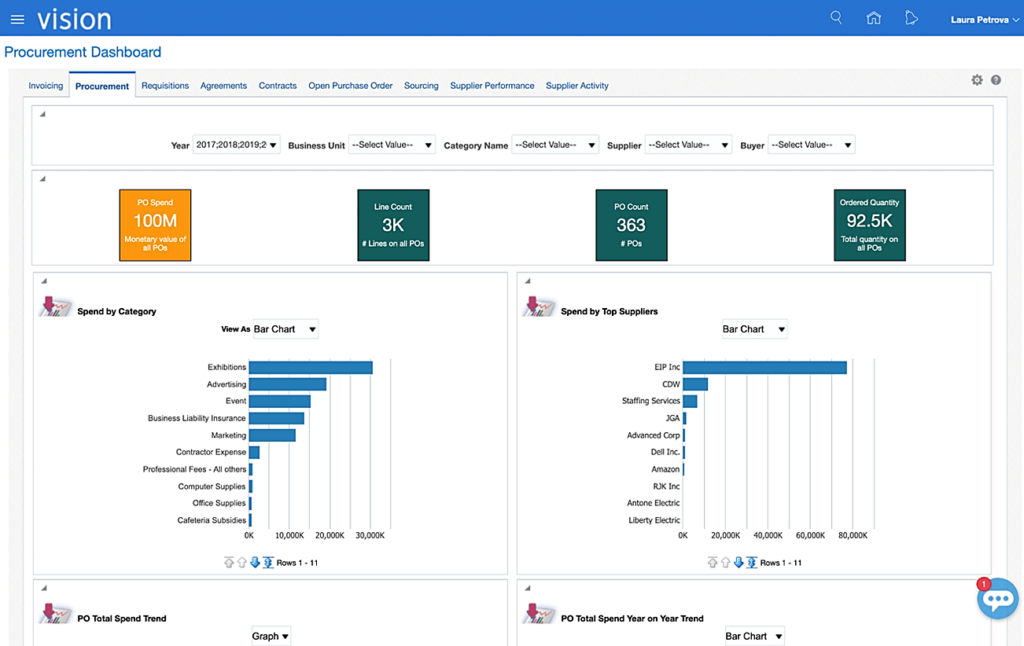
Source: Oracle
For instance, when a casual employee needs to purchase something from a list of approved suppliers, the powerful search capability will provide them with several options from the catalog.
Once they select what they need and place an order, they’ll receive confirmation that their purchase request was submitted.

Source: Oracle
From there, the relevant manager automatically receives an email notifying them of a pending approval.
Concurrently, the employee who made the requisition request can use their shopping interface to monitor when it will be approved, and a purchase order issued.
When the ordered goods arrive, the employee confirms their receipt, thus triggering an automated workflow where the system matches the invoice against the purchase order and, if everything is okay, sends that invoice for automatic payment.
Naturally, with so many solutions, features, and options, Oracle Procurement Cloud does not provide any specific prices; instead, you have to define what you need, contact them, and request a quote.
We could say that, if Oracle Procurement Cloud is designed for large enterprises, Oracle NetSuite caters more to small and mid-sized businesses.
More precisely, while Procurement Cloud offers more advanced features and customization options, NetSuite is more user-friendly and easier to implement.
Therefore, NetSuite is a robust procurement module within Oracle’s full-featured enterprise resource management (ERP) system.
This module promises to:
Here’s what their dashboard looks like.
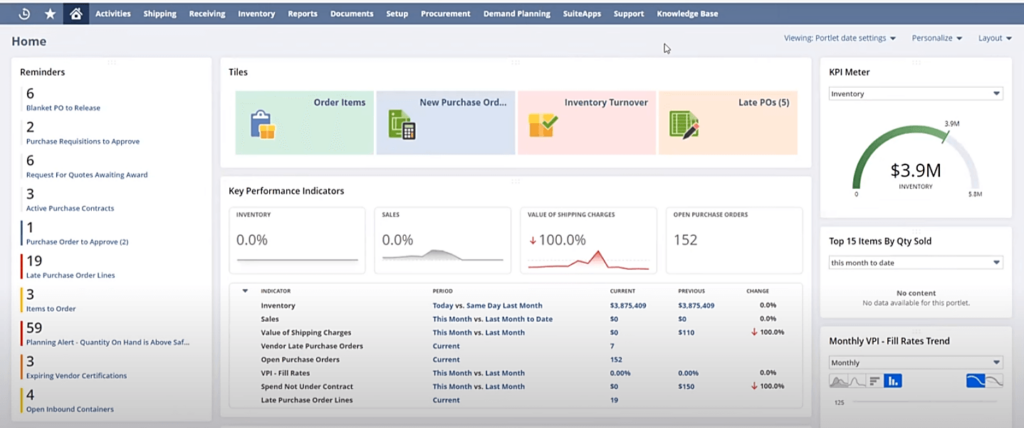
Source: NetSuite
In addition to procurement management, NetSuite also provides advanced vendor management features compiled under their vendor portal.
This portal allows managers to track supplier performance through vendor scorecards that contain all information related to each supplier within a central record.
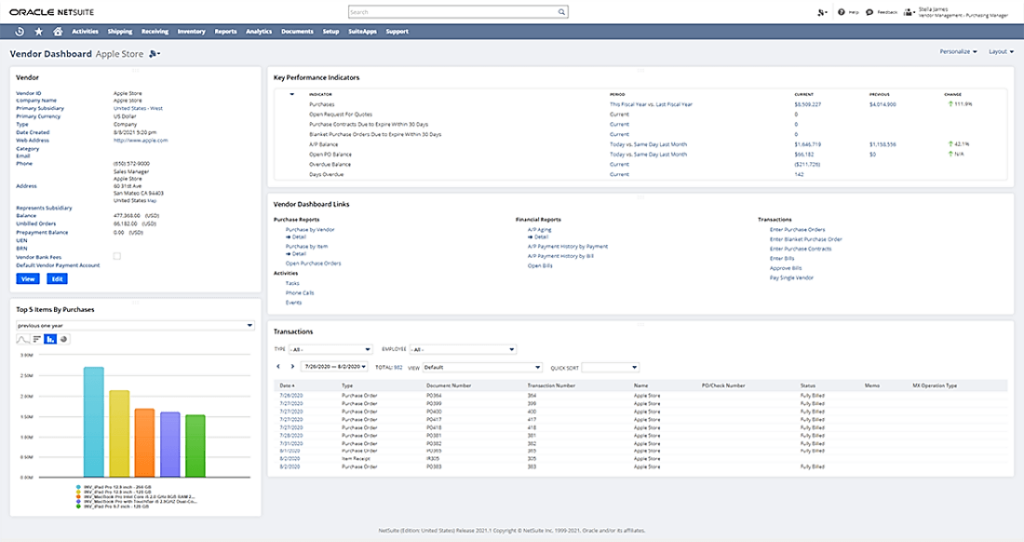
Source: NetSuite
This enables purchasing managers to easily monitor suppliers’ key performance indicators (KPIs) such as on-time delivery, defect rate, and lead time.
Moreover, vendors get an online portal where they can communicate and collaborate with your company, reducing inefficiencies.
In terms of pricing, NetSuite does not provide specific amounts but asks you to contact them.
Procurify is a cloud-based procurement and spend management platform that focuses on automating purchasing and accounts payable (AP) processes, helping companies tackle the related challenges.
In other words, Procurify’s easy-to-use platform is intended to save companies time and money they otherwise spent on manual processes, uninformed purchasing decisions, and maverick spending.

Source: Procurify
Like most other solutions mentioned here, this procure-to-pay platform offers a range of features from purchase requests, approvals, and order processing to contract and supplier management.
Here’s an overview of the key features.
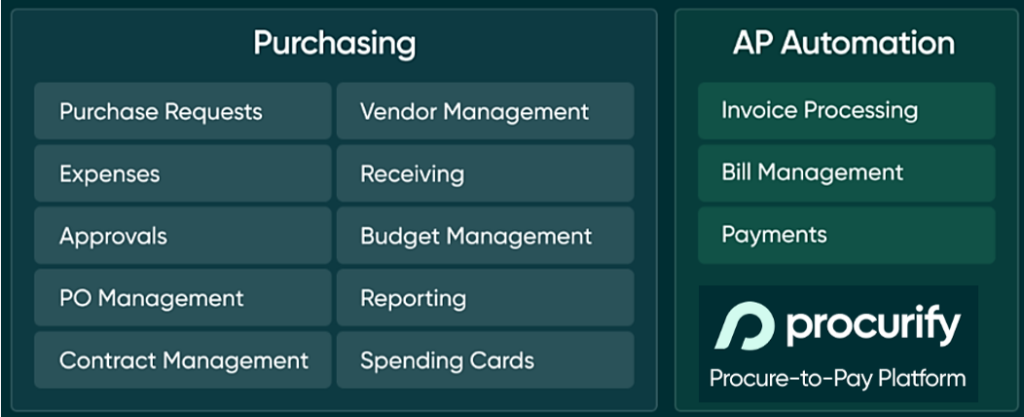
Source: Procurify
For example, Procurify’s Receiving feature is designed to streamline and automate the receiving process for goods and services.
More precisely, when a user opens a purchase order, they can track receiving documents to monitor the status of order fulfillment.
Moreover, they can easily verify and confirm the receipt of ordered goods and services.
Additionally, this feature enables the system to automatically run the three-way matching process, i.e., check for discrepancies between purchase orders, receiving documents, and invoices.

Source: Procurify
When it comes to pricing, Procurify joins the list of solutions that don’t provide specific amounts, as the prices of monthly/annual subscriptions can vary based on your company’s specific requirements.
Ramp is a procurement and expense management platform designed to help businesses manage spending efficiently.
Therefore, Ramp provides companies with an all-in-one spend management platform with advanced data tracking and workflow automations.
Naturally, this includes procurement.
Their procurement management solution promises to:
In other words, Ramp provides automated, platform-based workflows for all company stakeholders, as illustrated below.

Source: Ramp
For instance, employees get a central, easy-to-use, self-service point for submitting purchase requests, enabling them to efficiently order what they need in accordance with your procurement policy.
Your procurement team gets full visibility of procurement and spend management processes and, as more requests are handled by Ramp, more data insights that allow them to negotiate better supplier terms and identify cost-saving opportunities.
As for pricing, Ramp offers a free version with basic features, while Ramp Plus ($12 per user a month, billed annually) provides more flexibility, unlimited customizable workflows, and advanced user roles.
Lastly, Ramp also has an enterprise tier for large corporations with customized implementation needs, for which you’ll receive a price quote after contacting sales.
Kissflow offers a cloud-based workflow management platform aimed at enhancing all work processes, including procurement, through pre-built or custom-made process automations.
As a source-to-pay platform, Kissflow automates procurement processes, such as:
Moreover, Kissflow highlights its high customizability, meaning you can customize data fields, approval workflows, report formats, and more.
Here’s an overview of Kissflow’s main features, starting with strategic sourcing.
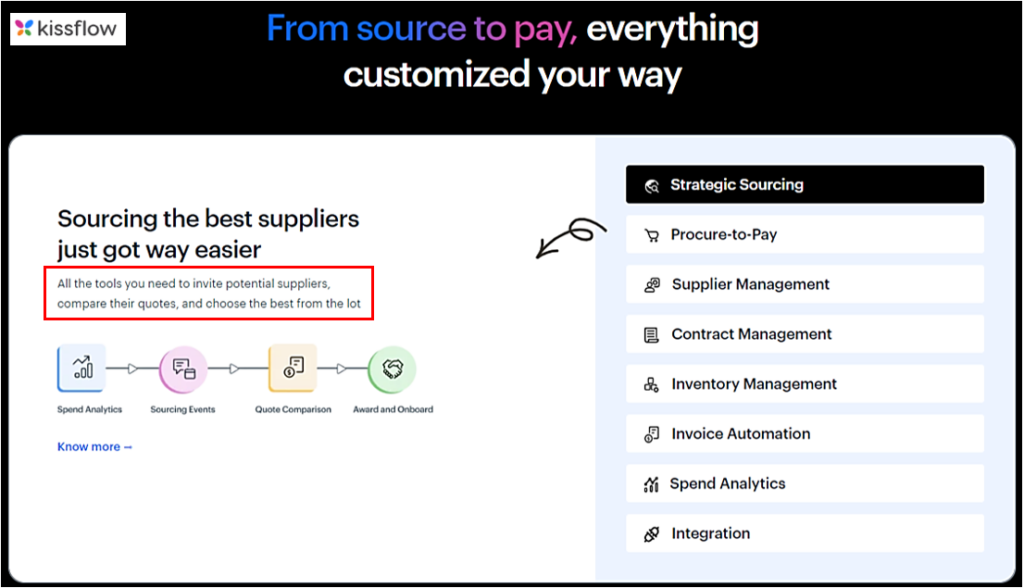
Source: Kissflow
This is a good opportunity to note that, while Kissflow and other solutions may automate and streamline many supplier sourcing processes, they generally lack the ability to quickly identify potential suppliers on a global scale.
That’s why Veridion’s database with the freshest supplier info, when integrated with one of these solutions, can significantly minimize the time and effort invested in supplier discovery.
This is also why one of Kissflow’s advantages is extensive procurement integrations, helping you break down data silos between different software solutions to create a single digital source of truth.

Source: Kissflow
As for pricing, Kissflow’s basic package with limited features starts at $1,500 a month, while the enterprise package with all features is custom-priced, i.e., you need to contact them with your requirements to get a quote.
GEP Smart is an AI-powered, all-in-one procurement management platform.
Similar to previous comprehensive source-to-pay solutions, GEP Smart aims to unify, automate, and streamline all direct and indirect procurement processes.
This includes everything from AI-driven spend analysis and cost savings tracking to facilitating the sourcing of suppliers and managing their contracts, payments, and relationships.
These key features are highlighted below.

Source: GEP Smart
What sets GEP Smart apart from other unified procurement software solutions is that it’s powered by GEP Minerva.
This is their proprietary AI model that enhances procurement analytics and decision-making.
This enables many advanced functions, such as:
The ultimate result of GEP Smart’s unified procurement platform is the GEP Smart Workplace.

Source: GEP Smart
As illustrated, GEP Smart covers all relevant stakeholders and leverages AI capabilities and cloud-based software advantages to provide ultimate functionality, mobility, and scalability.
This state-of-the-art procurement platform has too many features and options to provide any specific prices, so asking for a quote is required.
Coupa is a well-established, award-winning e-procurement management platform with AI-powered analytics.
Just like GEP Smart, Coupa offers an extensive range of features designed to digitize, automate, and streamline the entire procurement process.
Their primary focus is on spend management in procurement processes.
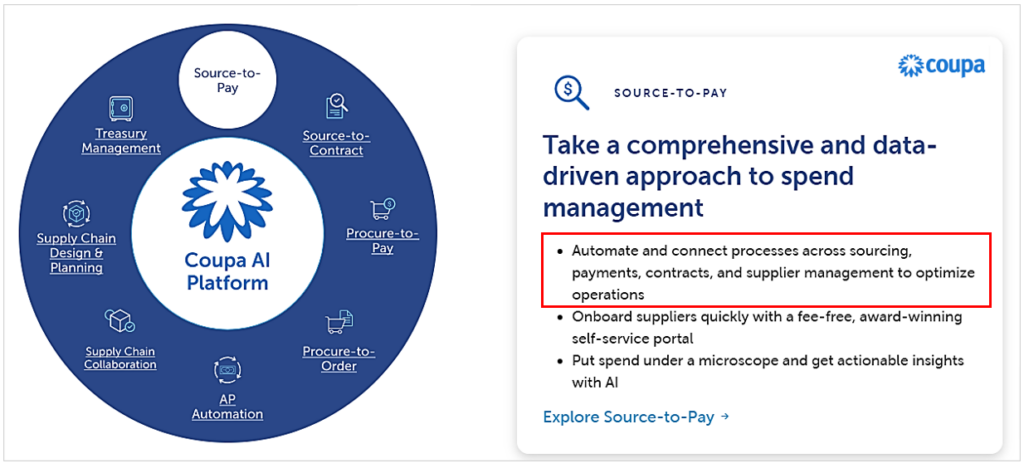
Source: Coupa
Another noteworthy feature is Coupa’s self-service portal where your suppliers may register for free and access the portal to monitor the lifecycle of their purchase order until invoice payment.
Once registered, you can exchange purchase orders and invoices in electronic form, streamlining further business.
Additionally, Coupa uses its extensive supplier database and AI-powered analytics to analyze anonymized data and provide financial benchmarks and helpful insights through their Coupa Community.ai.
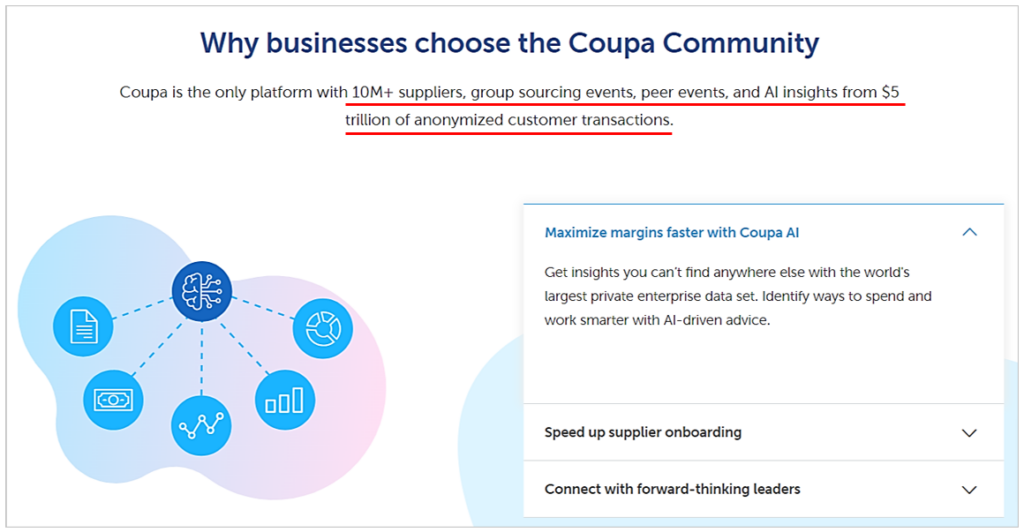
Source: Coupa
For instance, they can run aggregated statistical pricing analyses and provide pricing benchmarks for items frequently purchased across the Coupa Community.
This enables procurement teams to compare their supplier prices with industry averages and identify potential savings opportunities.
The scope of Coupa’s procurement management features, customizable options, and add-on services means pricing is not disclosed, meaning you should contact them for details.
Market Dojo offers a set of procurement management software tools for procurement automation, supplier engagement, and contract management.
However, their main strength is on-demand e-auctions that help procurement professionals streamline strategic sourcing, improve collaboration, and generate cost savings.
In other words, Market Dojo offers an e-sourcing platform where procurement teams can run RFQs, questionnaires, and negotiations via auctions/events.
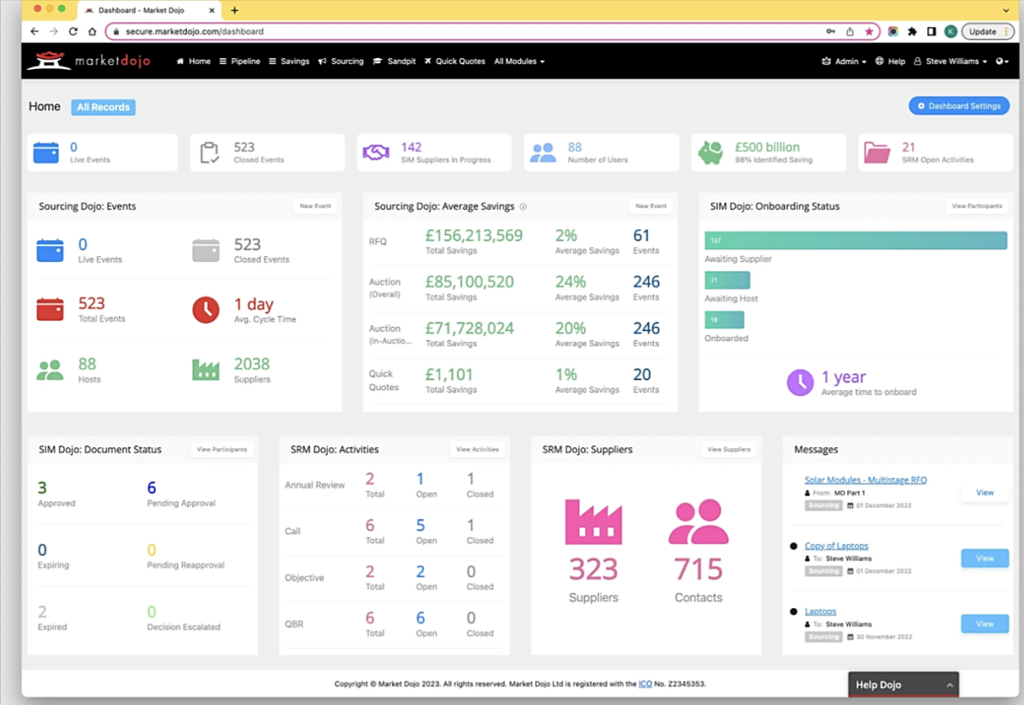
Source: Market Dojo
With the help of Market Dojo auctions, users can identify the most suitable suppliers in the market and analyze them against various criteria.
The “on-demand” part refers to Market Dojo’s pricing model.
It allows non-subscribers to run occasional auctions when they need to for a one-off fee and with no long-term commitment.

Source: Market Dojo
One more of Market Dojo’s advantages is its free “sandpit”: a virtual environment where you can set up and test your auctions before they go live.
Lastly, Market Dojo is transparent about its pricing, although the overlapping features between different packages could be better explained.
The on-demand, one-month license for e-auctions currently costs around $640.
As for other pricing packages, they range from $646 per license/user for Simple Sourcing to $1,615 for up to 500 suppliers under the Strategic Supplier Onboarding package.
Although we managed to cover these solutions only in broad strokes, we hope this article we’ll serve as a jumping point for your further research.
More precisely, to select the right procurement solution(s) for your business, you should take advantage of both online and offline research, quote requesting, demo scheduling, and free trials.
Additionally, prepare an extensive list of specific feature and pricing questions for your short-listed candidates to discern between must-have features and too-expensive add-ons.
These steps should enable you to select the right procurement management tools for your organization that will optimize your procurement processes, minimize costs, and maximize efficiency.